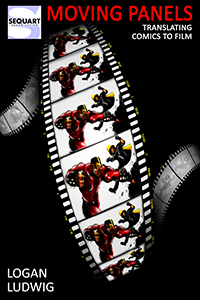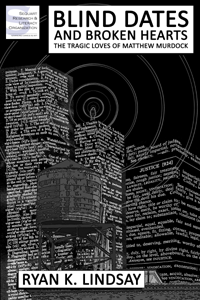Introduction—
Frank Miller and Alan Moore defined modern comics. While they were not the first writers to bring darkness, contemporary political issues or realism to comics, they helped shape the modern comics industry. For better or worse they made comics accessible to adults and they were challenging both to their audiences and comic companies themselves. Their works are still venerated today, despite becoming increasingly unpopular in recent years (more on that later). Nevertheless it is worthwhile to compare their approaches. While such comparisons are both arbitrary and generally biased, it is a fair pursuit. An artist’s work can and should speak for itself, and comparing one artist to another is arbitrary if they are working at a different genre or have very different intents with their work. But Moore and Miller are constantly cited (both positively and negatively) for beginning the modern age of super-hero comics. Both from a business perspective and an artistic perspective, Moore and Miller are the most significant writers in the comics medium since the work of the silver age by Stan Lee and his co-plotters Jack Kirby, Steve Ditko and John Romita Sr. The two have spoken very well about the other’s work (until recently) and their contribution to comics as a whole. So it is necessary to analyze their contributions to comics as both have had a critical influence on comics.
Super-heroes—
The most obvious comparison to make between Moore and Miller is their attitudes and approaches to super-heroes. Like it or not, (despite Moore’s vocal opinions) super-heroes are the dominant genre in the comics medium. Each writer’s most cited and praised works (Miller’s The Dark Knight Returns and Moore’s Watchmen) are deconstructions of the super-hero genre.
One of the most fascinating parallels is that Moore and Miller’s attitude to super-heroes have both drastically shifted as the years have gone on. Frank Miller began work in comics hating super-heroes, but grew to love them as the years went on. In contrast Alan Moore began loving super-heroes but has grown to despise them as the years have gone on.
In the beginning of Miller’s career, he hated super-heroes. Some interviews cleverly allude or accentuate this attitude, but simply from looking at Miller’s seminal run on Daredevil, it is clear that Miller was not particularly interested in doing the conventions of the genre. Miller liked the character Daredevil and wanted to draw him in the then bi-monthly comic. But Miller quickly got bored by the Roger McKenzie scripts which while enjoyable read as conventional and disposable super-hero escapism. Miller was much more interested in writing a crime book and when given an opportunity to write and draw Daredevil he quickly stripped away almost everything found in a conventional super-hero narrative save for the hero himself. Gone were the colorful, and hokey supervillains. Instead, Miller focused on providing ordinary thugs and assassins as enemies for Daredevil. Miller made Daredevil’s ultimate enemy the Kingpin, who wore no costume and was simply a cold and brilliant manipulator.
In Miller’s 25 issue run on Daredevil, he only included three conventional supervillains. The first was Gladiator who was utilized less as an actual villain but instead as an example of Matt Murdock’s belief in reform and maturation. Indeed, by the time Miller returned to Daredevil in the graphic novel Born Again, the Gladiator had become a civilian ally of Daredevil. The second supervillain Miller chose to include was Stilt Man, the only “freak of the week” villain that Miller allows in his gritty crime-comic. But Miller presented Stilt Man as intentionally ridiculous, with Stilt Man’s technology stolen by the incompetent Turk. Turk tries to defeat Daredevil as Stilt Man but ends up embarrassing himself even more. The single story serves as comic relief to some of the darker chapters in the run, but also proved to be a satire on the conventions of super-hero comics. Miller suggested that most conventional supervillains are idiotic with preposterous technology that proves to be genuinely ineffective.
Only Bullseye came out of Miller’s Daredevil as a serious threat to Matt Murdock. Miller permitted Bullseye to wear the costume. But Bullseye became less of a gimmick character, and simply a sociopathic assassin. Miller views Bullseye less as a conventional villain and more of a heartless hired-gun whose only eccentricity was a penchant for wearing tights. Miller radically changed super-hero comics, by turning a conventional and forgettable super-hero comic into a crime book. Miller found the character of Daredevil fascinating but found that the conventions of a super-hero narrative too narrow and clichéd, finding the seemingly generic mobsters far more menacing enemies. His most captivating villain in his run was the Kingpin, a strong fat man who was an untouchable crime lord. His insidious touch came in political corruption and manipulation rather than in super-weapons or the traditional super-villainy in comics.
In contrast to Miller who tried to break down nearly every traditional aspect of his super-hero narrative Alan Moore was subtly embracing every convention of the super-hero genre. It is curious that Moore is credited with “destroying” super-hero comics because, despite retconning and subverting several aspects, Moore was still writing within the conventions of the super-hero genre. In fact, in many ways Moore was simply re-telling the same style of stories that Siegel and Schuster did when they created the super-hero genre. Take his first super-hero work Marvelman (later renamed Miracleman). In the opening of Marvelman the eponymous hero stops terrorists from stealing a nuclear weapon. Moore’s revolutionary approach was showing the consequences of a super-being stopping terrorists with a man deafened by Marvelman’s transformation. Yet Moore still had the character following the conventions of a typical super-hero story. Even in the opening we had terrorists trying to steal nuclear weapons and were stopped by a super-hero who saves the world. What Moore was doing with Marvelman, was not destroying the conventions of the super-hero, but juxtaposing the fantastic of the super-hero genre with the real world.
Marvelman goes away from the magic explanation of super-powers, instead utilizing science-fiction origins to explain how Marvelman could lift cars like they were paper. But while there were much more realistic consequences to super-powers and political dimensions, Marvelman still follows much of the familiar tropes of super-hero comics. Marvelman still has his ultimate enemy be the stereotypical evil scientist Emil Gargunza. Gargunza’s plan in Moore’s Marvelman is just as elaborate and exotic as anything that Lex Luthor would be planning to defeat Superman with in a Golden Age story. Similarly Moore includes all of the seemingly silly concepts of Marvelman and his carbon copies, Marvelwoman, Kid Marvelman and even the ludicrous Marveldog. Marvelman teams-up with aliens whose actual arrival on Earth is as improbable as the secret race of intergalactic beings called Firedrakes. But because the work is taken with more realistic consequences and reactions, the narrative of the superhero genre seems vastly different. But at its heart Marvelman was applying all of the same conventions of a super-hero narrative to our world. Moore’s great contribution was applying such idle fantasy and escapism a more realistic setting in which consequences were demonstrated. In essence Moore was showing his love of super-heroes, but at the same time demonstrating that super-heroes belong in their four-color world rather than in the real world.
But as the years progressed Miller and Moore’s opinion began to shift as they began to embrace and reject super-heroes respectively.
































































I really enjoyed reading this. You make some great points about the differences between Frank Miller and Alan Moore. It never occurred to me that Frank didn’t like superheroes but you are right, he never really wrote about superpowered heroes. One thing that really struck me about his work is that his most powerful work (IMO) shows heroes without even a costume. After reading Born Again recently I realized that the most powerful scene for me was the last scene where Matt, without costume, fights a lunatic in the DD dudes. Matt had just gone through hell and back and is now at his most powerful… and he is without costume and not needing one any more. It’s almost a cathartic or symbolic thing that the he is fighting himself, or rather someone dressed as DD.
I can’t wait for the second part.
Thank you very much, and I love that moment in Born Again. It can be seen as the cleansed and greater Murdock confronting that mad version of himself, his nemesis. Hope you enjoy the continuing series.